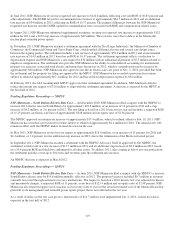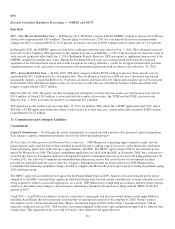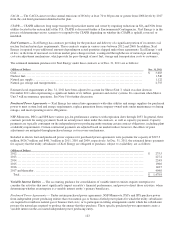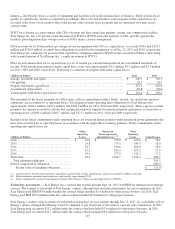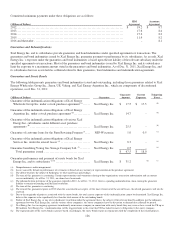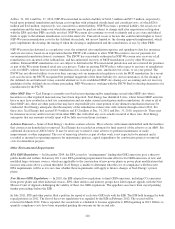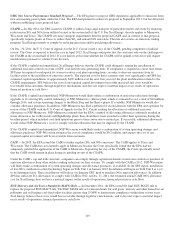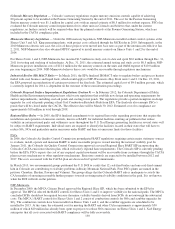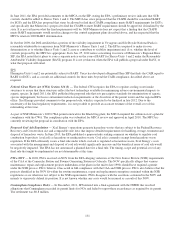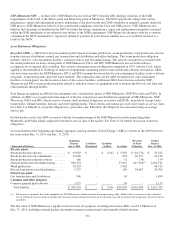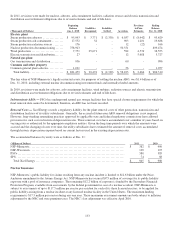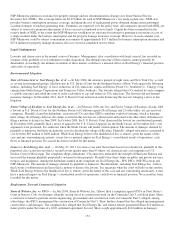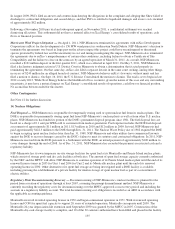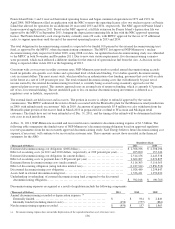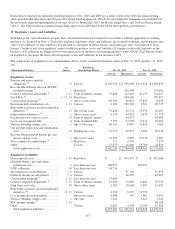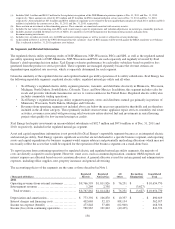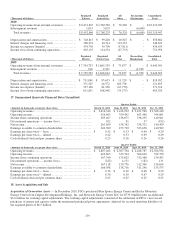Xcel Energy 2011 Annual Report Download - page 139
Download and view the complete annual report
Please find page 139 of the 2011 Xcel Energy annual report below. You can navigate through the pages in the report by either clicking on the pages listed below, or by using the keyword search tool below to find specific information within the annual report.129
GHG New Source Performance Standard Proposal — The EPA plans to propose GHG regulations applicable to emissions from
new and existing power plants under the CAA. The EPA had planned to release its proposal in September 2011, but has delayed it
without establishing a new proposal date.
CSAPR — In July 2011, the EPA issued its CSAPR to address long range transport of particulate matter and ozone by requiring
reductions in SO2 and NOx from utilities located in the eastern half of the U.S. For Xcel Energy, the rule applies to Minnesota,
Wisconsin and Texas. The CSAPR sets more stringent requirements than the proposed CATR and, in contrast to that proposal,
specifically requires plants in Texas to reduce their SO2 and annual NOx emissions. The rule also creates an emissions trading
program. Xcel Energy intends to comply by reducing emissions and/or purchasing allowances.
On Dec. 30, 2011, the U.S. Court of Appeals for the D.C. Circuit issued a stay of the CSAPR, pending completion of judicial
review. The Court is expected to hear the case in April 2012. Xcel Energy anticipates that the court may rule on the challenges to
the CSAPR in the second half of 2012. It is not known at this time whether the CSAPR will be upheld, reversed or will require
modifications pursuant to a future Court decision.
If the CSAPR is upheld and unmodified, Xcel Energy believes that the CSAPR could ultimately require the installation of
additional emission controls on some of SPS’ coal-fired electric generating units. If compliance is required in a short time frame,
SPS may be required to redispatch its system to reduce coal plant operating hours, in order to decrease emissions from its
facilities prior to the installation of emission controls. The expected cost for these scenarios may vary significantly and SPS has
estimated capital expenditures of approximately $470 million over the next four years for the plant modifications related to the
CSAPR requirements. SPS believes the cost of any required capital investment or possible increased fuel costs would be
recoverable from customers through regulatory mechanisms and does not expect a material impact on its results of operations,
financial position or cash flows.
If the CSAPR is upheld and unmodified, NSP-Minnesota would likely utilize a combination of emissions reductions through
upgrades to its existing SO2 control technology at NSP-Minnesota’s Sherco plant, which is estimated to cost a total of $10 million
through 2014, and system operating changes to the Black Dog and the Sherco plants. If available, NSP-Minnesota would also
consider allowance purchases. In addition, NSP-Minnesota has filed a petition for reconsideration with the EPA and a petition for
review of the CSAPR with the U.S. Court of Appeals for the D.C. Circuit seeking the allocation of additional emission
allowances to NSP-Minnesota. NSP-Minnesota contends that the EPA’s method of allocating allowances arbitrarily resulted in
fewer allowances for its Riverside and High Bridge plants than should have been awarded to reflect their operations during the
baseline period, which included coal-fired operations prior to their conversion to natural gas. If successful, additional allowances
would reduce NSP-Minnesota’s costs to comply with the reductions that may be imposed by the CSAPR.
If the CSAPR is upheld and unmodified, NSP-Wisconsin would likely make a combination of system operating changes and
allowance purchases. NSP-Wisconsin estimates the cost of compliance would be $0.2 million, and expects the cost of any
required capital investment will be recoverable from customers.
CAIR — In 2005, the EPA issued the CAIR to further regulate SO2 and NOx emissions. The CAIR applies to Texas and
Wisconsin. The CAIR does not currently apply in Minnesota because the Court specifically found that the EPA had not
adequately justified the application of the CAIR to Minnesota. In granting the stay of the CSAPR, the Court specifically noted
that the CAIR would remain in place during its pending review of the CSAPR.
Under the CAIR’s cap and trade structure, companies can comply through capital investments in emission controls or purchase of
emission allowances from other utilities making reductions on their systems. To comply with the CAIR in 2012, NSP-Wisconsin
will likely make a combination of system operating changes and allowance purchases, if available. In the SPS region, installation
of low-NOx combustion control technology began on Tolk Unit 1 in January 2012. Installation will begin on Tolk Unit 2 at a yet
to be determined date. These installations will reduce or eliminate SPS’ need to purchase NOx emission allowances. In addition,
SPS has sufficient SO2 allowances to comply with CAIR in 2012. At Dec. 31, 2011, the estimated annual CAIR NOx allowance
cost for Xcel Energy does not have a material impact on the results of operations, financial position or cash flows.
EGU Mercury and Air Toxics Standards (MATS) Rule — In December 2011, the EPA issued the final EGU MATS rule to
replace the proposed EGU MACT rule. The EGU MATS rule sets emission limits for acid gases, mercury and other hazardous air
pollutants and will require coal-fired utility facilities greater than 25 MW to demonstrate compliance within three to four years.
Xcel Energy believes these costs would be recoverable through regulatory mechanisms, and it does not expect a material impact
on its results of operations, financial position or cash flows.


